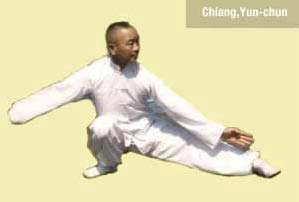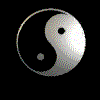Yang, Pan-Hou - 1834 to1902 [2]
Wang, Jao-Yu - 1836 to 1939
Kuo Lien Ying - 1897 to 1984
Chiang, Yun-Chun - 1922 to Present
Daniel Dean Harrington - 1948 to Present
 YANG, PAN-HOU was the second son of Yang, Lu-chan. The first son died young. Pan-hou was small of stature, agile and quick tempered by nature. Both he and his younger brother, Yang, Chien-hou, were forced to train in Tai Chi Chuan by their father [4].
YANG, PAN-HOU was the second son of Yang, Lu-chan. The first son died young. Pan-hou was small of stature, agile and quick tempered by nature. Both he and his younger brother, Yang, Chien-hou, were forced to train in Tai Chi Chuan by their father [4].They were not very happy about the hard work and Chien-hou is said to have run away at one point [5]. It is also said that both brothers thought of joining a Buddhist Monastery to get away from home. The training was hard and constant. Yang, Lu-chan was known to have been a demanding father and teacher [4].
 KUO, LIEN-YING had an interesting and long life. I first met him in San Francisco in 1972. At that time, he was teaching in San Francisco's China town. He was northern Chinese and said to have grown up in Hu Ho Hao Te, Inner Mongolia [3]. I was told, he took up Shaolin boxing and the classical fighting weapons as a youth and was a bodyguard in his early years [5]. While in his 20s, he heard of Wang, Jiao-yu in Beijing and sought him out [3]. He was refused entrance as a student for 6 months and accepted after repeatedly asking to be taught [5]. Many years of intense practice are required to master an internal martial art and teachers tested a students' resolve to learn before being accepted. It was from Wang, Jiao-yu that Kuo, Lien-ying learned the art and method of Tai Chi Chuan. He went on to master Ba-gua and Shing-yi and became one of China's most noted practitioners of the internal arts [3]. He was, also, a congressman in the National Assembly of China during the Republic of China [3]. He was given a state funeral by the Peoples Republic of China when he died in 1984 [5]. He had a number of Chinese and non-Chinese students. Chiang Yun- chun was Kuo's student in Taiwan during the 50s and early 60s [5].
KUO, LIEN-YING had an interesting and long life. I first met him in San Francisco in 1972. At that time, he was teaching in San Francisco's China town. He was northern Chinese and said to have grown up in Hu Ho Hao Te, Inner Mongolia [3]. I was told, he took up Shaolin boxing and the classical fighting weapons as a youth and was a bodyguard in his early years [5]. While in his 20s, he heard of Wang, Jiao-yu in Beijing and sought him out [3]. He was refused entrance as a student for 6 months and accepted after repeatedly asking to be taught [5]. Many years of intense practice are required to master an internal martial art and teachers tested a students' resolve to learn before being accepted. It was from Wang, Jiao-yu that Kuo, Lien-ying learned the art and method of Tai Chi Chuan. He went on to master Ba-gua and Shing-yi and became one of China's most noted practitioners of the internal arts [3]. He was, also, a congressman in the National Assembly of China during the Republic of China [3]. He was given a state funeral by the Peoples Republic of China when he died in 1984 [5]. He had a number of Chinese and non-Chinese students. Chiang Yun- chun was Kuo's student in Taiwan during the 50s and early 60s [5]. CHIANG, YUN-CHUN teaches and lives in El Cerrito, California. He is a noted painter, internal martial artist, calligrapher, and Oriental Medical Doctor. He is the former chairman of the California State Board of Examiners of Oriental Medicine. He is master of the Wen Wu school of traditional Chinese arts in El Cerrito. Master Chiang was a student of Kuo Lien Ying and Wang Chih Chien both of whom were students of Wang Jiao-yu.
CHIANG, YUN-CHUN teaches and lives in El Cerrito, California. He is a noted painter, internal martial artist, calligrapher, and Oriental Medical Doctor. He is the former chairman of the California State Board of Examiners of Oriental Medicine. He is master of the Wen Wu school of traditional Chinese arts in El Cerrito. Master Chiang was a student of Kuo Lien Ying and Wang Chih Chien both of whom were students of Wang Jiao-yu. Master Chiang is considered a master of the five excellencies of Chinese culture. He has mastered internal healing and boxing arts. They are: Tai Chi Chuan, Ba-gua, Shing-yi, Shaolin (and it's off shoot styles), Fukien White (RYU HE CHUAN) Crane, and various Chi-gung styles, Chinese classical weapons, strategy, and philosophy. Additionally, he has mastered and teaches traditional Chinese painting, calligraphy, and seal carving. Some of his paintings and calligraphy reside in museums in the West and East. His paintings were presented to U.S. Presidents Eisenhower and Carter during their administrations. He recently was given a retrospective art showing at the Chiang Kai-shek memorial hall in Taipei, R.O.C..
As a result of the revolution in the early 1900s, Sun Yat-sin's resolve to create an open and healthy China inspired the masters of various arts to open their studies to the general public. Yang, Chen-fu taught the Beijing style of Yang Tai Chi at the Republic's school for martial arts. His intention was to help Chinese people gain strength and good health from the practice[4]. Sun's principle of openness was,also, practiced by master Kuo. Master Chiang follows in this same tradition. War disrupted the development of the Republic and most students of Chinese history are familiar with the Communist's and the Kuomintong's prolonged war during the Japanese occupation of China. Due to the Communist take over in China, master Kuo and master Chiang made their way to Taiwan. Master Kuo went to San Francisco in the middle 1960s followed by master Chiang in the late 60s. Master Chiang is from Da Ming city in Heipei Province, China.



